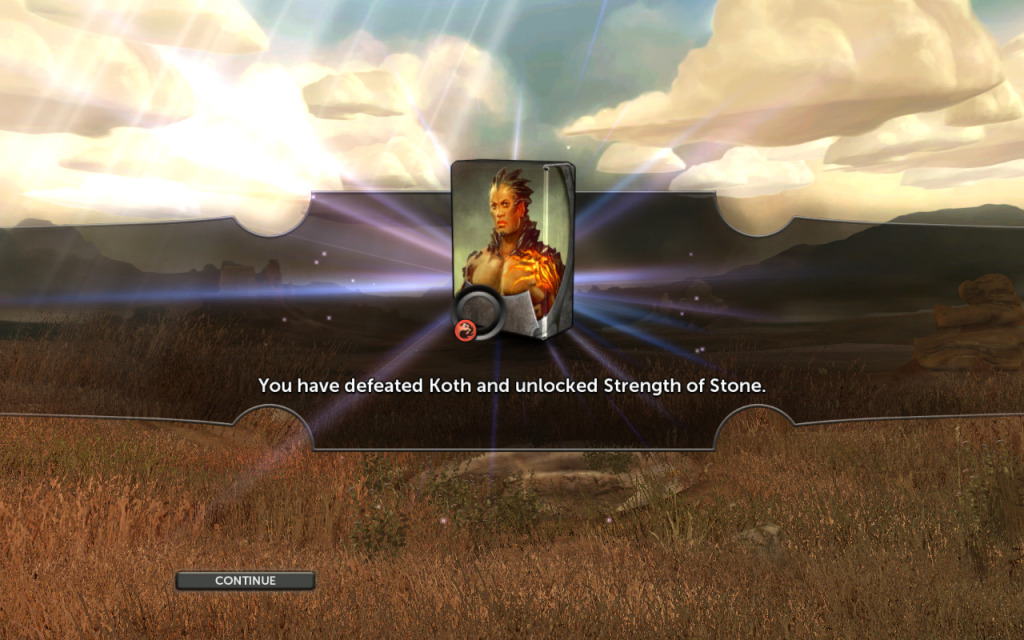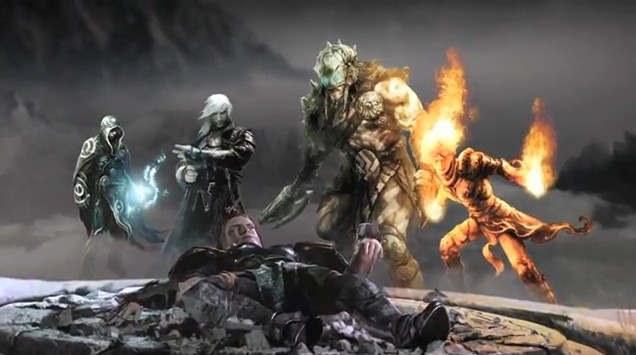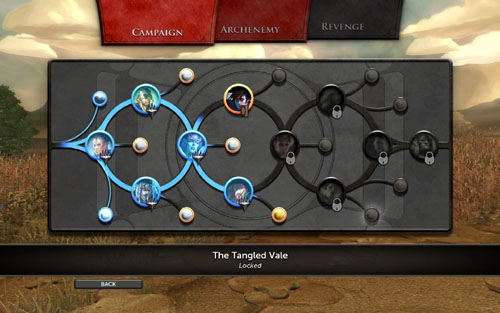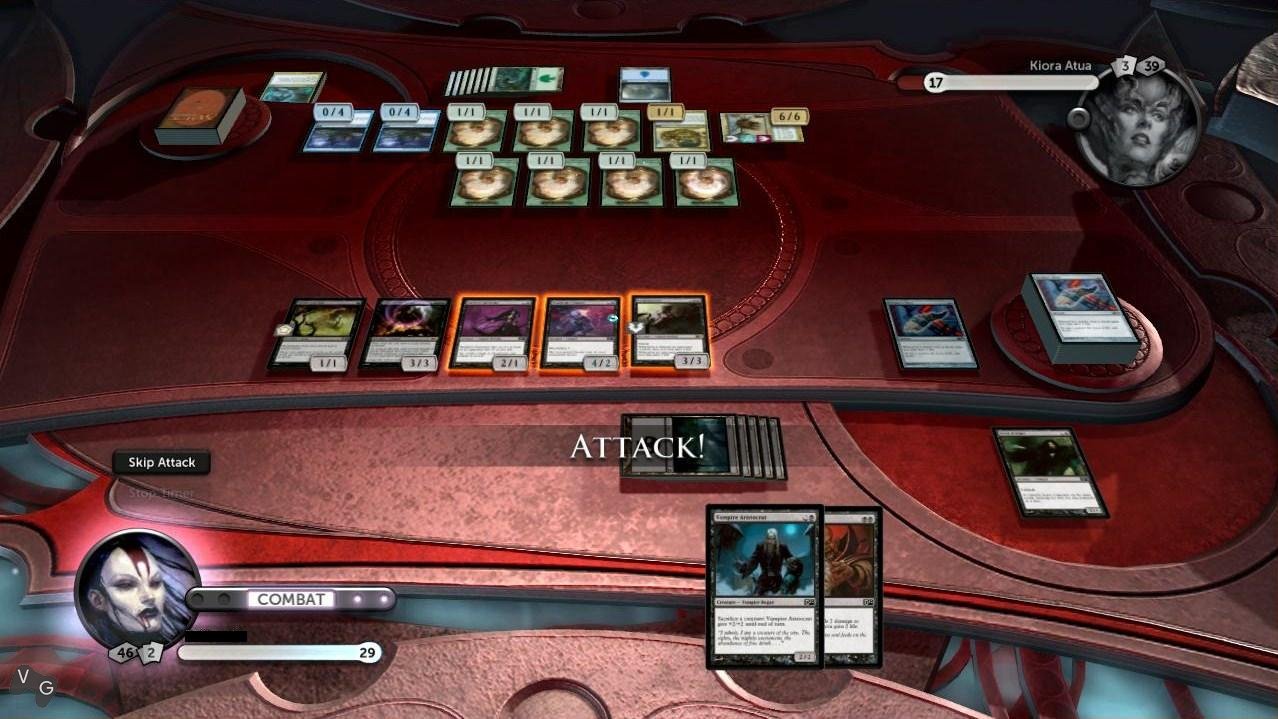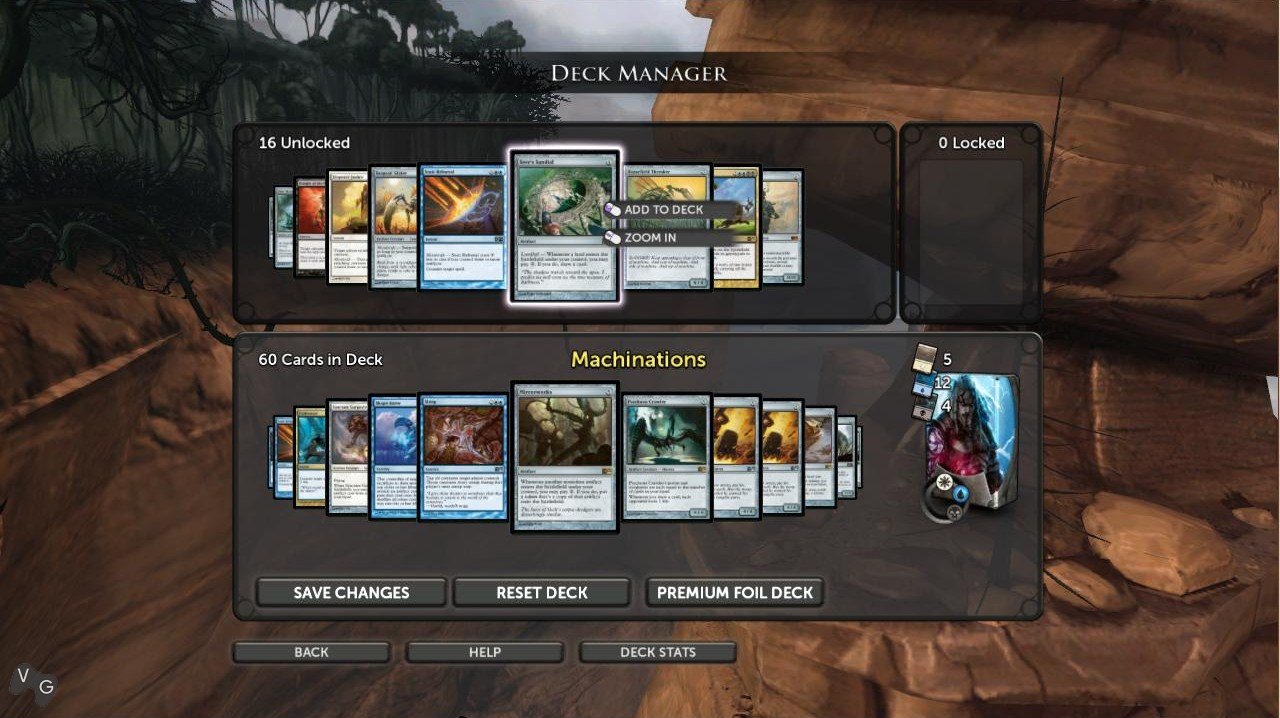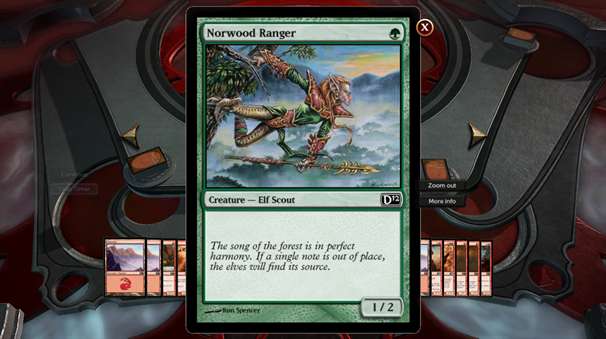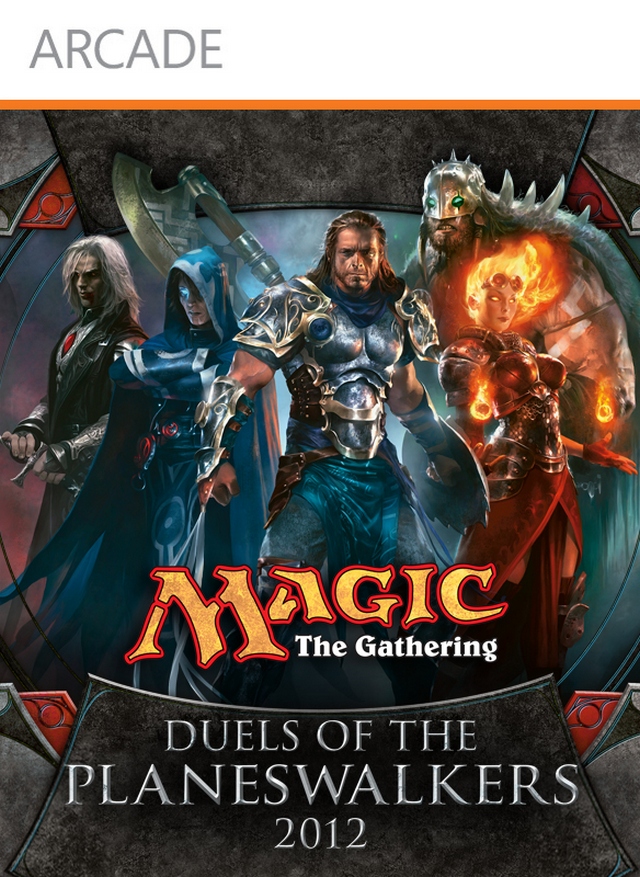
Magic the Gathering – Duels of the Planeswalkers 2012
Developer: Stainless Games
Publisher: Wizards of the Coast
Platform: XBLA (Reviewed), PSN, PC/MAC
Release Date: June 14, 2011
Price: 800 MSP (Available HERE), $9.99 USD on Steam and PSN
Premise:
As a collectible card game series, Magic the Gathering is known by many gamers and card game players alike as being one of the longest running and most successful card-game franchises to date. Since first release in 1993, the game has expanded and grown into a hugely successful franchise spanning over dozens of series and generations of cards. As a result of both the intellectual challenge that the game offers, as well as the sophisticated art style applied to each individual card, Magic the Gathering (or MtG) is typically viewed amongst gamers as the collectible card game for adults. Unlike card game series such as Pokémon or Yu Gi Oh, which have had their popularity bolstered thanks to anime and cartoon adaptations, for many years, MtG has been able to stand out on its own. However, as a popular series, it too has spawned a line of novels, comic books and video game adaptations for fans to embroil themselves in. Duels of the Planeswalkers 2012 is the latest installment in the video game series that has attempted to capture the core gameplay behind the physical card game that fans know and love. At the same time however, the game has also presented players with a few new gameplay innovations that might very well change some of the future multiplayer aspects of the series. Attempting to innovate while staying true to the roots of what made the series popular is a daunting task for any game series. The question is, has it been able to strike that fine balance?
Story/Campaign:
Duels of the Planeswalkers 2012 is the second game in the ‘DotP’ series to be released on the Xbox Live Arcade, Steam and the Playstation Network. For a game based around battling collectible trading cards, one would not typically approach a game such as this with any strong expectations of story. What has been presented however is pleasantly surprising. After building up a legacy of 18 years, there is much Magic the Gathering lore that has been developed over that time. However, very little of this lore is actually explored in the card game rendition. The introduction of a small story element to the campaign mode allows fans of the series to finally see the universe in which Magic the Gathering takes place.
The world of Magic the Gathering is actually comprised of multiple worlds or dimensions. These worlds are all distinct in their own individual ways, but all share some common features, such as all adhering to the same magical and physical laws of the universe. Each world is set in a medieval era and setting, where warriors and monsters roam the lands, and the only real justice is that enacted by the strong over the weak. These different worlds are known as “Planes”. These planes are usually named after specific generations or series of the card-game, such as “Zendikar” and “Mirrodin”. Generally, the different planes don’t interact directly with each other, except through a select few who have the ability to traverse space and travel between these worlds. They are known as ‘Planeswalkers’, hence the title. In addition to the ability to traverse these different realms, Planeswalkers are also masters of the elements, able to summon legions of powerful creatures and cast devastating spells to further their own personal goals. In essence, the Planeswalkers are basically the players of the card game.
The story of the campaign mode begins from the moment the game is begun, told from the perspective of a Planeswalker named Gideon. Gideon recounts how his own actions is his own world had almost led to its complete destruction. Using his ability to traverse the other worlds, he encounters other Planeswalkers who share his abilities and powers, events which he describes as a “reckoning”. Learning from his battles, he has resolved to “fight the very tyrant he had become”, describing the rise of a Dragon that also happens to be a planeswalker. However, despite all of his own power and knowledge, Gideon has so far been unable to best the Dragon Planeswalker named Nicol Bolas. As a last ditch effort to save his world, Gideon summons the other Planeswalkers he had previously faced into his own plane seeking their aid. “Gather your allies” is the tagline of the plot.
This story is introduced to players all during the opening cinematic. Unfortunately in playing the game itself, the story essentially dies off, as no other cinematics or plot points show up in areas other than the loading screens. Even then, the loading screens only detail information about the pasts of some of the Planeswalkers involved in the story of wider MtG lore. While this attempt at adding plot to the game certainly educates players in regards to the nature of the MtG universe, it could have been better executed. If new story elements were to arise during the game, or after beating certain levels or challenges, I believe there could have been even greater potential for players to explore the MtG universe. However, that said, the fact that some background information has been provided at all is a step up from the previous Duels of the Planeswalkers game. In the end, the story is not the most crucial element of a card game, but I do feel that perhaps a little more could have been explored.
Gameplay:
The true goal for any rendition of any series of non-electronic game should be to capture the essence of the core gameplay features within the game itself. To do so with a largely popular series like Magic the Gathering, the gameplay must also be well structured and flow well for the players. As is the case with the real physical card game, there are specific rules that have to be adhered to, or else the game will fall apart.
Fans of the card game series will be happy to note that the game does adhere to the conventional rules of the card game series very closely. In fact in some ways, the video game rendition is structurally better than playing the physical game. In a real life game of MtG, there are instances in which players may accidentally or intentionally deviate from the rules, thereby throwing off the pace of the game due to human error. Something as simple as forgetting to draw a card at the beginning of a turn can end up being a huge disadvantage. When playing the video game rendition, the rules and stages of each turn are specifically highlighted on the HUD, and the game will only progress in ways that adhere to the official rulebook.
For those unfamiliar with playing collectible card games such as this, never fear, a HIGHLY helpful tutorial mode is made available at the very beginning of the game for players who wish to run through the finer points and rules of the game. The tutorial introduces players not only to the different types and functions of cards, but also to the proper rules and progression of each player turn. By allowing the player to interact in the tutorial, players are more likely to grasp rules and concepts far better than if they were just lectured to them in a video or text block.
Aside from the tutorial, the game features a variety of single and multiplayer game types to choose from. One of the features I found great about the game was the use of AI controlled opponents. While for most games this features would be a necessity, one must remember that it takes at least 2 players to play a round of MtG. In real life, you need at least 2 people. However, in the video game rendition, players are able to play through against computer controlled opponents. This makes the game widely appealing to gamers and fans of the MtG series who are in the mood to play a quick card game without the need to go and find a second player with equal skills and knowledge of the Magic the Gathering card game. The different game modes also feature some of the newer new Magic the Gathering innovations. The main innovation in gameplay is a game mode called ‘Archenemy’, a game type only released last year, so not many players are yet familiar with this mode. This game basically pits 3 players against 1, where the lone player has expanded health, and a variety of event cards to give them a huge advantage over the stock standard group. This is essentially your “boss battle” scenario. Additionally, the game also has added up to 4 player free for all, in addition to the standard 1v1 and 2 v2 “two headed giant” game types presented in the 2009 rendition. Each of these game types can be played locally or online.
The gameplay mechanics themselves are based around a turn-based play system in which 2-4 players duel each other, either in a free for all match, a 1 on 1, or in various multiplayer variants. The general purpose of the game is to defeat your enemy player without being beaten yourself. Finding a creative battle strategy, or a balance between offense and defense will often tip the tides of a battle. The specific rules of the MtG card game are far too numerous to mention in a simple review, but here’s an abridged version for those of you who might be interested in seeing what all the fuss is about. In a standard match, two players begin the game with 20 health each. The purpose of the game is to find a way to defeat your opponent. This can be done in one of several ways. The first, and most common way to achieve victory, is to reduce your opponents health to 0 or less. This is achieved by summoning creatures to the battlefield to attack the enemy player, or through the use of offensive spells. However, one might opt for a more creative strategy by making the opponent player run out of usable cards in their deck, or by poisoning the player with 10 poison tokens.
It should be noted that there are hundreds of cards available for use in the game, although it is probably worth noting what types players are likely to expect. The first and most basic sets of cards are the land cards. By playing land cards, players obtain mana to summon creatures and spells, and use abilities. There are five different types of land which correspond with the five different colors of the game.
- The Plains, which charge White mana. White cards users typically focus on building a strong defense, and using buff spells to augment their creatures.
- The Mountains, which charge Red mana. Red card users often opt for fast paced attacks with creatures, and will often favor dealing direct damage to a player with spells, without the need for creature combat. Perfect for those who favor rush tactics.
- The Islands, which charge Blue mana. Blue card users tend to utilize spells which target the technical aspects of the MtG card game itself, often by using un-summoning techniques, and by stopping enemy players using spells altogether.
- The Forests, which charge Green mana. Green card users typically play by summoning the really REALLY big creatures and damage deals, while also bolstering their own health and mana pools.
- The Swamps, which charge Black mana. Black card users are notorious for using instant death techniques, and health draining abilities. They also have an affinity for dealing damage to players indirectly, and being able to bring fallen creatures back from the grave.
Each of these different color types has at least one deck built around that single color alone. For players that are just starting the game, they will notice that only two of the color decks: Green and White, are available to start with. However, players are able to unlock more decks and more advanced cards to bolster their decks as they duel and defeat enemy Planeswalkers throughout the campaign. It should be noted though that no player is restricted to using only the one color. In fact more than half of the decks are a combination of two colors. Many people who play the real game are likely to be thankful for the variety, but a little bit disappointed if there are no decks which specifically match their play style.
For instance, as a player of the physical MtG game myself, I tend to favor using a combination of Red and Green cards, with my strongest decks featuring Dragons, and the mighty Eldrazzi beings. However, there is no combination deck that caters to that exact fancy. This brings up the only real major criticism I have to the gameplay. This is not so much in regards to the gameplay itself, but rather the so-called “customization feature”. The game advertises that deck customization is possible in the game, but this only accounts for specific unlockable cards that can only be used with a specific deck. And each deck only features around 16 extra unlockable cards to use. In a deck that already features 60 cards, a player would be stupid not to use those 16. By automatically adding the extra cards to the player deck, offering “deck customization” becomes pretty redundant.
Now, there is no question that attempting to program the mechanics of the thousands of magic cards in existence would have required a lot of time and hard drive space to achieve. It is unreasonable to think that every card ever could be included to allow every tactic style in an electronic rendition of a long running card game series. However, if players were provided with the option to create their own decks from the cards available in the video game already, I believe this would have been a greatly welcomed feature by fans. The nature of collectible card games is the ability to discover and trade cards with one another to help bolster one’s own decks through customization. Adding such a feature would greatly improve the longevity of the game, and even promote online multiplayer, so gamers can show off their play style to others. However, by restricting the customization to be deck specific, it waters down the experience to a degree. This does not, however, make the game unplayable by any means, but one is certainly able to see how this particular omission deviates the video game rendition from the possibilities of the real life game.
Graphics and Sound:
The graphics utilized in this title are admittedly not a central focal point. However, as an XBLA title, I do have to admit that the design of the card battlefields are quite clever. For playing something as simple as a card game, the layout of the HUD makes it feels like something far more epic. The addition of combat sounds and animations to combat steps during play also puts forward an effective immersive illusion that makes the player feels that they are battling with actual creatures and spells as opposed to just simple trading cards.
What is also worth mentioning is the artwork of the cards themselves. This feature is not so much of the video game, but of the card game. One of the reasons for MtG’s popularity is the artwork style of the card themselves. Each type of card has a unique scene pictured of creatures, spells or events which have been drawn and signed off by professional artists. The art style itself is also quite consistent among each card, always providing a feel of darkness and a readiness battle.
The sound effects of the game are pretty standard fare, with a myriad of card sounds and battle effects to compliment the animation. What’s worth noting is the background music. It is able to change depending on the game type being played, or the opponent being faced. Each time however, the pace of the music is quite slow, often featuring a rhythmical beat which is not overly stimulating to the senses. The purpose of choosing a lyric-less slow paced soundtrack provides a sense of deep thought that is to be undertaken. MtG is an intellectual game, and as such, thought is required before one makes their move. The background music supports this notion.
Conclusion:
Magic the Gathering – Duels of the Planeswalkers 2012 is most certainly a welcome addition to the Xbox Live Arcade, Steam and PSN. For fans of the card game, such as myself, you will find much to like in this new rendition of a long running legacy. I often make a personal point of trying not to hold games that are reviewed to the candles of other games. Each should be able to stand out on its own. However, I feel that the developer should have looked at the customization issue a little longer. It was the major criticism of the first game, and it hasn’t really been altered or addressed in the second installment. Game companies should, fundamentally, learn from past errors and correct them in future installments. However, as it stands, DotP 2012 stands up on its own very well, even without the advanced customization feature. Regardless of whether you’re a fan of the card game itself, or just looking to get in on a mentally stimulating arcade style game, Duels of the Planeswalkers 2012 is definitely worth a go.



